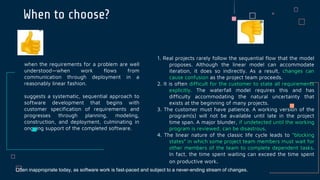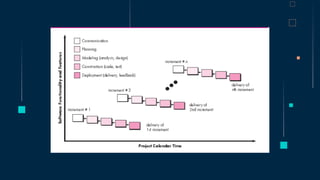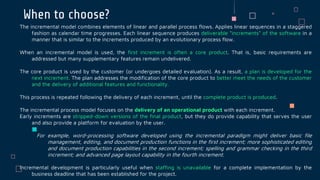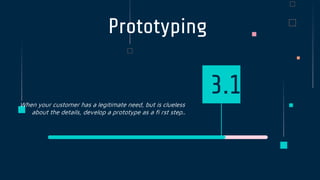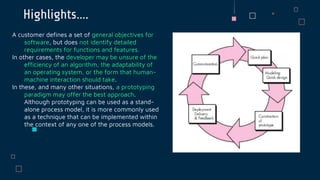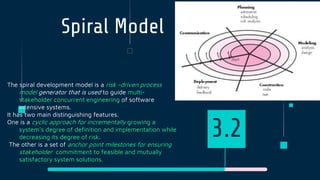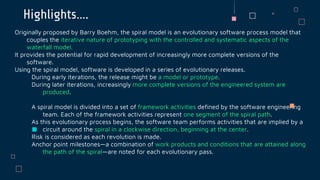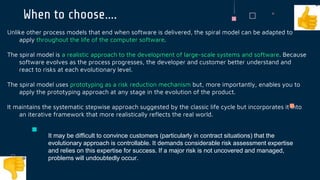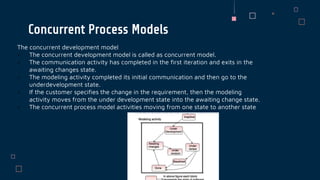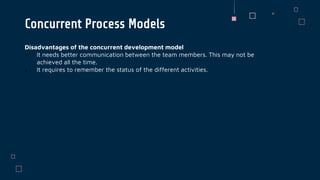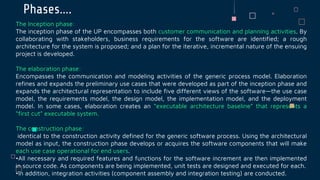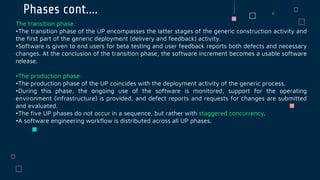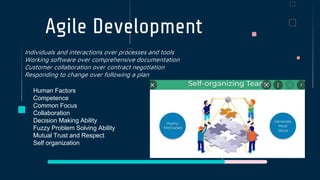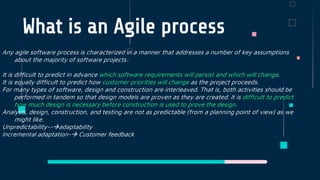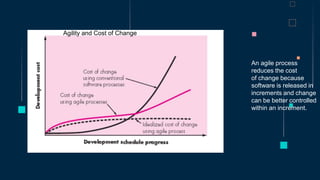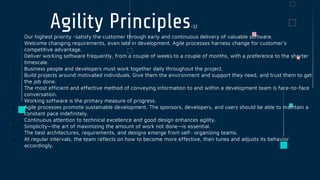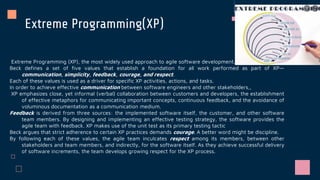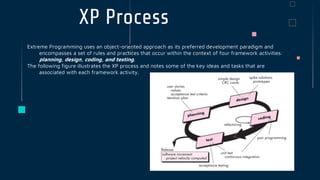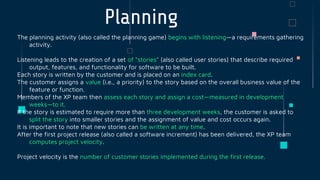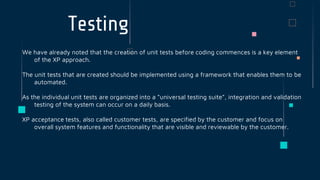Software Engineering -UNIT1 - Part2.pptx
- 1. Process Models A process model provides a specific roadmap for software engineering work. It defines the flow of all activities, actions and tasks, the degree of iteration, the work products, and the organization of the work that must be done.
- 2. Generic Process Model Process - a collection of work activities, actions, and tasks that are performed when some work product is to be created. Each of these activities, actions, and tasks reside within a framework or model that defines their relationship with the process and with one another. A generic process framework for software engineering defines five framework activities ŌĆö communication, planning, modeling, construction, and deployment. Each framework activity is populated by a set of software engineering actions. Each software engineering action is defined by a task set that identifies the work tasks that are to be completed, the work products that will be produced, the quality assurance points that will be required, and the milestones that will be used to indicate progress. One important aspect of the software process called process flowŌĆödescribes how the framework activities and the actions and tasks that occur within each framework activity are organized with respect to sequence and time.
- 3. PROCESS FLOW
- 4. Defining a Framework Activity
- 5. Sample- For a small software project requested by one person (at a remote location) with simple, straightforward requirements. Communication Activity a phone call or email with the appropriate stakeholder. tasks (the task set ) that this action encompasses are: Task set 1. Make contact with stakeholder via telephone. 2. Discuss requirements and develop notes. 3. Organize notes into a brief written statement of requirements. 4. Email to stakeholder for review and approval.
- 7. Prescriptive Process Models Prescriptive process models were originally proposed to bring order to the chaos of software development. Software engineering work and the product that it produces remain on ŌĆ£the edge of chaos.ŌĆØ All software process models can accommodate the generic framework activities, but each applies a different emphasis to these activities and defines a process flow that invokes each framework activity in a different manner.
- 8. Waterfall Model Classic lifecycleŌĆ”.Although the original waterfall model proposed by Winston Royce [Roy70] made provision for ŌĆ£feedback loops,ŌĆØ the vast majority of organizations that apply this process model treat it as if it were strictly linear. 01
- 9. When to choose? when the requirements for a problem are well understoodŌĆöwhen work flows from communication through deployment in a reasonably linear fashion. suggests a systematic, sequential approach to software development that begins with customer specification of requirements and progresses through planning, modeling, construction, and deployment, culminating in ongoing support of the completed software. 1. Real projects rarely follow the sequential flow that the model proposes. Although the linear model can accommodate iteration, it does so indirectly. As a result, changes can cause confusion as the project team proceeds. 2. It is often difficult for the customer to state all requirements explicitly. The waterfall model requires this and has difficulty accommodating the natural uncertainty that exists at the beginning of many projects. 3. The customer must have patience. A working version of the program(s) will not be available until late in the project time span. A major blunder, if undetected until the working program is reviewed, can be disastrous. 4. The linear nature of the classic life cycle leads to ŌĆ£blocking statesŌĆØ in which some project team members must wait for other members of the team to complete dependent tasks. In fact, the time spent waiting can exceed the time spent on productive work. Often inappropriate today, as software work is fast-paced and subject to a never-ending stream of changes.
- 10. Incremental Model The incremental model delivers a series of releases, called increments, that provide progressively more functionality for the customer as each increment is delivered. 02
- 12. When to choose? The incremental model combines elements of linear and parallel process flows. Applies linear sequences in a staggered fashion as calendar time progresses. Each linear sequence produces deliverable ŌĆ£incrementsŌĆØ of the software in a manner that is similar to the increments produced by an evolutionary process flow. When an incremental model is used, the first increment is often a core product. That is, basic requirements are addressed but many supplementary features remain undelivered. The core product is used by the customer (or undergoes detailed evaluation). As a result, a plan is developed for the next increment. The plan addresses the modification of the core product to better meet the needs of the customer and the delivery of additional features and functionality. This process is repeated following the delivery of each increment, until the complete product is produced. The incremental process model focuses on the delivery of an operational product with each increment. Early increments are stripped-down versions of the final product, but they do provide capability that serves the user and also provide a platform for evaluation by the user. For example, word-processing software developed using the incremental paradigm might deliver basic file management, editing, and document production functions in the first increment; more sophisticated editing and document production capabilities in the second increment; spelling and grammar checking in the third increment; and advanced page layout capability in the fourth increment. Incremental development is particularly useful when staffing is unavailable for a complete implementation by the business deadline that has been established for the project.
- 13. Evolutionary Process Model Evolutionary process models produce an increasingly more complete version of the software with each iteration. but a limited version must be introduced to meet competitive or business pressure; a set of core product or system requirements is well understood, but the details of product or system extensions have yet to be defined. Evolutionary models are iterative. They are characterized in a manner that enables you to develop increasingly more complete versions of the software. There are two common evolutionary process models. 03
- 14. Prototyping When your customer has a legitimate need, but is clueless about the details, develop a prototype as a fi rst step.. 3.1
- 15. HighlightsŌĆ”. A customer defines a set of general objectives for software, but does not identify detailed requirements for functions and features. In other cases, the developer may be unsure of the efficiency of an algorithm, the adaptability of an operating system, or the form that human- machine interaction should take. In these, and many other situations, a prototyping paradigm may offer the best approach. Although prototyping can be used as a stand- alone process model, it is more commonly used as a technique that can be implemented within the context of any one of the process models.
- 16. Spiral Model The spiral development model is a risk -driven process model generator that is used to guide multi- stakeholder concurrent engineering of software intensive systems. It has two main distinguishing features. One is a cyclic approach for incrementally growing a systemŌĆÖs degree of definition and implementation while decreasing its degree of risk. The other is a set of anchor point milestones for ensuring stakeholder commitment to feasible and mutually satisfactory system solutions. 3.2
- 17. HighlightsŌĆ”. Originally proposed by Barry Boehm, the spiral model is an evolutionary software process model that couples the iterative nature of prototyping with the controlled and systematic aspects of the waterfall model. It provides the potential for rapid development of increasingly more complete versions of the software. Using the spiral model, software is developed in a series of evolutionary releases. During early iterations, the release might be a model or prototype. During later iterations, increasingly more complete versions of the engineered system are produced. A spiral model is divided into a set of framework activities defined by the software engineering team. Each of the framework activities represent one segment of the spiral path. As this evolutionary process begins, the software team performs activities that are implied by a circuit around the spiral in a clockwise direction, beginning at the center. Risk is considered as each revolution is made. Anchor point milestonesŌĆöa combination of work products and conditions that are attained along the path of the spiralŌĆöare noted for each evolutionary pass.
- 18. When to chooseŌĆ”. Unlike other process models that end when software is delivered, the spiral model can be adapted to apply throughout the life of the computer software. The spiral model is a realistic approach to the development of large-scale systems and software. Because software evolves as the process progresses, the developer and customer better understand and react to risks at each evolutionary level. The spiral model uses prototyping as a risk reduction mechanism but, more importantly, enables you to apply the prototyping approach at any stage in the evolution of the product. It maintains the systematic stepwise approach suggested by the classic life cycle but incorporates it into an iterative framework that more realistically reflects the real world. It may be difficult to convince customers (particularly in contract situations) that the evolutionary approach is controllable. It demands considerable risk assessment expertise and relies on this expertise for success. If a major risk is not uncovered and managed, problems will undoubtedly occur.
- 19. The concurrent development model ’ā╝ The concurrent development model is called as concurrent model. ’ā╝ The communication activity has completed in the first iteration and exits in the awaiting changes state. ’ā╝ The modeling activity completed its initial communication and then go to the underdevelopment state. ’ā╝ If the customer specifies the change in the requirement, then the modeling activity moves from the under development state into the awaiting change state. ’ā╝ The concurrent process model activities moving from one state to another state Concurrent Process Models
- 20. Disadvantages of the concurrent development model ’āś It needs better communication between the team members. This may not be achieved all the time. ’āś It requires to remember the status of the different activities. Concurrent Process Models
- 21. Unified Process Model During the early 1990s James Rumbaugh, Grady Booch, and Ivar Jacobson began working on a ŌĆ£unified methodŌĆØ that would combine the best features of each of their individual object-oriented analysis and design methods and adopt additional features proposed by other experts in object-oriented modeling. The result was UMLŌĆöa unified modeling language that contains a robust notation for the modeling and development of object-oriented systems. By 1997, UML became a de facto industry standard for object-oriented software development. UML provided the necessary technology to support object-oriented software engineering practice, but it did not provide the process framework to guide project teams in their application of the technology. Later they developed the Unified Process, a framework for object-oriented software engineering using UML. 4
- 22. PhasesŌĆ”. The Inception phase: The inception phase of the UP encompasses both customer communication and planning activities. By collaborating with stakeholders, business requirements for the software are identified; a rough architecture for the system is proposed; and a plan for the iterative, incremental nature of the ensuing project is developed. The elaboration phase: Encompasses the communication and modeling activities of the generic process model. Elaboration refines and expands the preliminary use cases that were developed as part of the inception phase and expands the architectural representation to include five different views of the softwareŌĆöthe use case model, the requirements model, the design model, the implementation model, and the deployment model. In some cases, elaboration creates an ŌĆ£executable architecture baselineŌĆØ that represents a ŌĆ£first cutŌĆØ executable system. The construction phase: identical to the construction activity defined for the generic software process. Using the architectural model as input, the construction phase develops or acquires the software components that will make each use case operational for end users. ŌĆóAll necessary and required features and functions for the software increment are then implemented in source code. As components are being implemented, unit tests are designed and executed for each. ŌĆóIn addition, integration activities (component assembly and integration testing) are conducted.
- 23. Phases contŌĆ”. The transition phase: ŌĆóThe transition phase of the UP encompasses the latter stages of the generic construction activity and the first part of the generic deployment (delivery and feedback) activity. ŌĆóSoftware is given to end users for beta testing and user feedback reports both defects and necessary changes. At the conclusion of the transition phase, the software increment becomes a usable software release. ŌĆóThe production phase: ŌĆóThe production phase of the UP coincides with the deployment activity of the generic process. ŌĆóDuring this phase, the ongoing use of the software is monitored, support for the operating environment (infrastructure) is provided, and defect reports and requests for changes are submitted and evaluated. ŌĆóThe five UP phases do not occur in a sequence, but rather with staggered concurrency. ŌĆóA software engineering workflow is distributed across all UP phases.
- 24. Agile Development Agile software engineering combines a philosophy and a set of development guidelines. The philosophy encourages customer satisfaction and early incremental delivery of software; small, highly motivated project teams; informal methods; minimal software engineering work products; and overall development simplicity. The development guidelines stress delivery over analysis and design (although these activities are not discouraged), and active and continuous communication between developers and customers. JANE DOE
- 25. Agile Development Individuals and interactions over processes and tools Working software over comprehensive documentation Customer collaboration over contract negotiation Responding to change over following a plan 4 Human Factors Competence Common Focus Collaboration Decision Making Ability Fuzzy Problem Solving Ability Mutual Trust and Respect Self organization
- 26. What is an Agile process Any agile software process is characterized in a manner that addresses a number of key assumptions about the majority of software projects: It is difficult to predict in advance which software requirements will persist and which will change. It is equally difficult to predict how customer priorities will change as the project proceeds. For many types of software, design and construction are interleaved. That is, both activities should be performed in tandem so that design models are proven as they are created. It is difficult to predict how much design is necessary before construction is used to prove the design. Analysis, design, construction, and testing are not as predictable (from a planning point of view) as we might like. Unpredictability--’āĀadaptability Incremental adaptation-’āĀ Customer feedback
- 27. An agile process reduces the cost of change because software is released in increments and change can be better controlled within an increment. Agility and Cost of Change
- 28. Agility Principles-12 1. Our highest priority -satisfy the customer through early and continuous delivery of valuable software. 2. Welcome changing requirements, even late in development. Agile processes harness change for customerŌĆÖs competitive advantage. 3. Deliver working software frequently, from a couple of weeks to a couple of months, with a preference to the shorter timescale. 4. Business people and developers must work together daily throughout the project. 5. Build projects around motivated individuals. Give them the environment and support they need, and trust them to get the job done. 6. The most efficient and effective method of conveying information to and within a development team is face-to-face conversation. 7. Working software is the primary measure of progress. 8. Agile processes promote sustainable development. The sponsors, developers, and users should be able to maintain a constant pace indefinitely. 9. Continuous attention to technical excellence and good design enhances agility. 10. SimplicityŌĆöthe art of maximizing the amount of work not doneŌĆöis essential. 11. The best architectures, requirements, and designs emerge from selfŌĆō organizing teams. 12. At regular intervals, the team reflects on how to become more effective, then tunes and adjusts its behavior accordingly.
- 29. Extreme Programming(XP) Extreme Programming (XP), the most widely used approach to agile software development. Beck defines a set of five values that establish a foundation for all work performed as part of XPŌĆö communication, simplicity, feedback, courage, and respect. Each of these values is used as a driver for specific XP activities, actions, and tasks. In order to achieve effective communication between software engineers and other stakeholders,, XP emphasizes close, yet informal (verbal) collaboration between customers and developers, the establishment of effective metaphors for communicating important concepts, continuous feedback, and the avoidance of voluminous documentation as a communication medium. Feedback is derived from three sources: the implemented software itself, the customer, and other software team members. By designing and implementing an effective testing strategy, the software provides the agile team with feedback. XP makes use of the unit test as its primary testing tactic Beck argues that strict adherence to certain XP practices demands courage. A better word might be discipline. By following each of these values, the agile team inculcates respect among its members, between other stakeholders and team members, and indirectly, for the software itself. As they achieve successful delivery of software increments, the team develops growing respect for the XP process.
- 30. XP Process Extreme Programming uses an object-oriented approach as its preferred development paradigm and encompasses a set of rules and practices that occur within the context of four framework activities: planning, design, coding, and testing. The following figure illustrates the XP process and notes some of the key ideas and tasks that are associated with each framework activity.
- 31. The planning activity (also called the planning game) begins with listeningŌĆöa requirements gathering activity. Listening leads to the creation of a set of ŌĆ£storiesŌĆØ (also called user stories) that describe required output, features, and functionality for software to be built. Each story is written by the customer and is placed on an index card. The customer assigns a value (i.e., a priority) to the story based on the overall business value of the feature or function. Members of the XP team then assess each story and assign a costŌĆömeasured in development weeksŌĆöto it. If the story is estimated to require more than three development weeks, the customer is asked to split the story into smaller stories and the assignment of value and cost occurs again. It is important to note that new stories can be written at any time. After the first project release (also called a software increment) has been delivered, the XP team computes project velocity. Project velocity is the number of customer stories implemented during the first release. Planning
- 32. Design XP design rigorously follows the KIS (keep it simple) principle. A simple design is always preferred over a more complex representation. XP encourages the use of CRC cards as an effective mechanism for thinking about the software in an object-oriented context. CRC (class-responsibility-collaborator) cards identify and organize the object-oriented classes that are relevant to the current software increment. If a difficult design problem is encountered as part of the design of a story, XP recommends the immediate creation of an operational prototype of that portion of the design, called a spike solution. A central notion in XP is that design occurs both before and after coding commences. Refactoring means that design occurs continuously as the system is constructed.
- 33. Coding After stories are developed and preliminary design work is done, the team does not move to code, but rather develops a series of unit tests Once the unit test has been created, the developer is better able to focus on what must be implemented to pass the test. Once the code is complete, it can be unit-tested immediately, thereby providing instantaneous feedback to the developers. A key concept during the coding activity is pair programming. XP recommends that two people work together at one computer workstation to create code for a story. This provides a mechanism for real time problem solving (two heads are often better than one) and real-time quality assurance (the code is reviewed as it is created). It also keeps the developers focused on the problem at hand.
- 34. Testing We have already noted that the creation of unit tests before coding commences is a key element of the XP approach. The unit tests that are created should be implemented using a framework that enables them to be automated. As the individual unit tests are organized into a ŌĆ£universal testing suiteŌĆØ, integration and validation testing of the system can occur on a daily basis. XP acceptance tests, also called customer tests, are specified by the customer and focus on overall system features and functionality that are visible and reviewable by the customer.
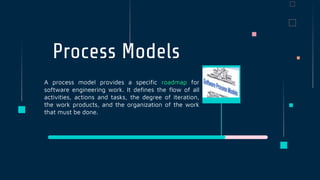
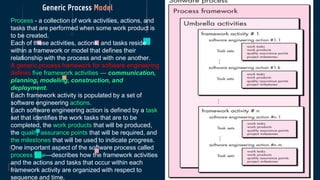
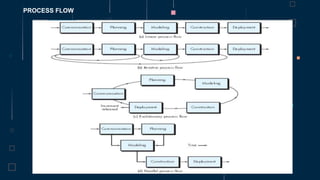



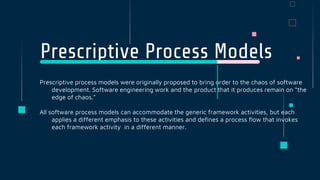
![Waterfall Model
Classic lifecycleŌĆ”.Although the original waterfall model proposed by
Winston Royce [Roy70] made provision for ŌĆ£feedback loops,ŌĆØ the
vast majority of organizations that apply this process model treat it
as if it were strictly linear.
01](https://image.slidesharecdn.com/se-unit1-part2-240718100053-7e452c24/85/Software-Engineering-UNIT1-Part2-pptx-8-320.jpg)
